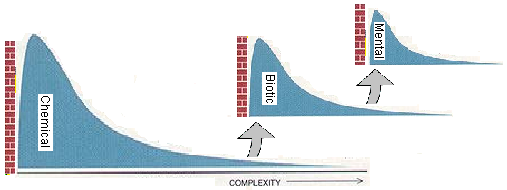
| Palaeos: |  |
Cosmic Evolution |
| Cosmic Evolution | Emergence |
|
Cosmos Abiotic Life Mind Posthuman/Postsapient |
Cosmic Evolution
Complexity The Self-Organizing Universe Big History Deep Time Cosmic Evolution Glossary References |
 The thin black line connects the canonical milestones specified by different scientists and reference works, and also represents the average complexity change at a given milestone. The vertical axis depicts the logarithm of the change in complexity. Caption and diagram from Modis 2002 |
As explained, systems theory can be used to understand the emergence of complex structures, i.e. evolution, in the cosmic context. When strategic forecaster Theodore Modis, compared thirteen lists of key events in cosmic, biological, and human history, by different scientists and academics he found they corroborated each other, even though the details of the lists sometimes differed. The result is a map of the growth of organised complexity in the universe, shown at the right (Modis 2002). Whether this logarithmic curve represents a genuine acceleration of evolutionary change, as the transhumanists argue (Kurzweil 2005), or is simply an artifact of logarithmic time or our unavoidable anthropocentric perspective, is not clear. But however one looks at the bigger picture, it is clear that the cosmos, at least locally, has produced complex and highly organised systems, which have developed from the original disorganised state of the quantum soup that characterised the early Big Bang universe. This is why I have distinguished evolution in the cosmological or big picture context from evolution in the more restricted biological context. Both are true, but the latter is only a subset of the former. MAK111013
Some Darwinian evolutionists like Stephen Jay Gould who famously rejected directional evolution , the idea that evolution as the emergence of complexity in the context of the evolution of life on Earth, because it implied ascent, Gould's argument is shown by the following diagram.
 Stephen Jay Gould's argument against evolution tending to complexity. Life emerges next to the "left wall" of minimal complexity. This prokaryote or bacterial style of life has remained most common and most successful from the Precambrian to the Present. A few creatures occasionally move to the right, thus extending the right tail in the distribution of complexity. Many more move to the left,where they are absorbed within space already occupied. The bacterial mode has not changed position, but just grown higher (more abundant) through time. Diagram from Stephen Jay Gould, The Evolution of Life on Earth, Scientific American, October, 1994. |
Here, the brick wall is the minimum level of complexity for life. Now, just as during the Archean eon, most life is still at the bacterial/prokaryote level of organisation. Hence there is no ascent.
No disrespect intended, but the problem here is that Gould, for all his insight, was still considering things from only a purely quantitative and biological point of view. Systems theory provides a much broader field than biological evolution, and this does show the general emergence of more complex levels of organisation. This actually does not contradict Gould's diagram, as a modified version will show:
 Modified version of above diagram. Each higher emergent level of complexity constitutes a sort of singularity that leads leads to a new evolutionary level or plateau, each with its own minimum complexity "wall" and its long tail, some of which may exceed in complexity the simpler levels of the next evolutionary stratum above it. Each higher evolutionary level is still less abundant than the one below it; most of the matter in the universe still consists of elementary particles, postulated dark matter, and charged atomic nuclei and free photons and electrons in stars and in interstellar space. For the sake of convenience, only three evolutionary strata are shown, although many more could be postulated. |
So there would be a brick wall for the minimum complexity of life; another for the minimum complexity of eukaryote life, which is more complex than prokaryotes because it requires internal membranes, organelles, and so on, another for the minimum complexity of multicellular eukaryote life, another for intelligence and sociocultural evolution, and so on. Similarly prior to life there is the minimum complexity of complex organic molecules, and of simple molecules (as stages of chemical or abiotic evolution), and below them of atoms, and so on, down to the fundamental building blocks of quantum particles and the superstrings or whatever that they are made of. In the end we are left with the standard step-wise diagram. It's just a matter of how it is interpreted. MAK111014
| Page Back The Self-Organizing Universe | Unit Home | Page Top | Page Next: Big History Deep Time |
last revised MAK111014, edited RFVS111024
